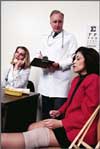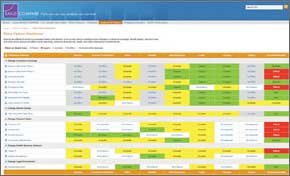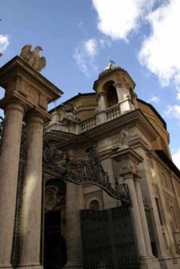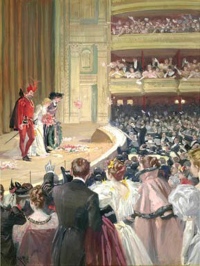Internet Sites Selected for the Readers of Duke University Libraries
Museum of Yo-Yo History

Despite its long and colorful history, no toy may be as maligned as the yo-yo. The roots of the yo-yo can be traced back to antiquity: a Grecian urn in the collection of the Metropolitan Museum of Art depicts that most well-known of yo-yo maneuvers, walking the dog.
Those with a penchant for the yo-yo will appreciate the wide range of materials that can be found on this site, particularly the appealing online exhibit of valuable yo-yos, such as the 1984 Olympics “No Jive” model. Those who want to continue their exploration of the yo-yo should visit the “Profiles & History” area of the website for player and company profiles, along with historical photographs of yo-yos in action.
Fashion Plate Collection
content.lib.washington.edu/costumehistweb/
 There are fashion plates, and then there are the exquisite fashion plates that constitute the University of Washington Libraries’ digitized collection. The plates were collected by long-time home economics professor Blanche Payne, who taught at the University from 1927 to 1966. The plates come from leading French, American, and British fashion journals of the 19th and early 20th century, and they document stylistic periods such as empire, romantic, Victorian, and Edwardian. An introductory essay about the collection of over 400 plates can be browsed alphabetically or by subject. Rounding out the site are a brief essay on fashion trends and an extended excerpt from the 1913 book Dame fashion, a commentary on the history and transformation of various fashions during the 19th century.
There are fashion plates, and then there are the exquisite fashion plates that constitute the University of Washington Libraries’ digitized collection. The plates were collected by long-time home economics professor Blanche Payne, who taught at the University from 1927 to 1966. The plates come from leading French, American, and British fashion journals of the 19th and early 20th century, and they document stylistic periods such as empire, romantic, Victorian, and Edwardian. An introductory essay about the collection of over 400 plates can be browsed alphabetically or by subject. Rounding out the site are a brief essay on fashion trends and an extended excerpt from the 1913 book Dame fashion, a commentary on the history and transformation of various fashions during the 19th century.
Central Park
As one of the world’s greatest urban green spaces, Central Park is loved by dyed-in-the-wool New Yorkers as well as visitors to the city. This reverential website presents detailed information about this fine public space and its history as well as the activities that take place within its 843 acres. Visitors to the website can peruse maps of the park, learn about its many features, and browse a selection of photographs of this urban paradise. The homepage contains much of this material, along with a “News” feature, which provides updates about goings on throughout Central Park. For those planning a visit, the “Events” and “Attractions” sections will be most useful, as they include information about such draws as the zoo, rock climbing, ice skating lessons, swimming, tennis, outdoor theatre, and restaurants.
Ballparks of Baseball

In some ways, nothing says summer in the United States like sitting outside in a ballpark and watching nine innings of America’s favorite sport. This loving tribute to the venues—past, current, and future—that have housed various professional baseball teams is a great introduction to some of the most hallowed and reviled ballparks around the country. The “Features” section includes updated news about ballparks, videos of baseball stadiums, seating charts, and attendance figures by ballpark back to 1890. Within that same section, visitors can chime in and rate their “ballpark experience” at different ballparks around the country.
From The Scout Report, Copyright Internet Scout 1994-2010.
With this roundup of Internet picks, we say thanks and farewell to Joline Ezzell, who will retire in May 2010.






 Everyone has had the frustrating experience of not being able to remember a particular word or phrase. Fortunately, there is now the OneLook Reverse Dictionary website that is a remedy for this situation. Essentially, a user enters a concept into a search engine and receives a list of pertinent words and phrases. For example, typing in “joy from the pain of others” returns over one hundred results, including “schadenfreude.” The site offers several additional options, including searches for related concepts, the foreign translation for a word, or basic identifications. Perhaps the most important function of the Reverse Dictionary is that users (if they are so inclined) can also use the database to solve crossword puzzle clues.
Everyone has had the frustrating experience of not being able to remember a particular word or phrase. Fortunately, there is now the OneLook Reverse Dictionary website that is a remedy for this situation. Essentially, a user enters a concept into a search engine and receives a list of pertinent words and phrases. For example, typing in “joy from the pain of others” returns over one hundred results, including “schadenfreude.” The site offers several additional options, including searches for related concepts, the foreign translation for a word, or basic identifications. Perhaps the most important function of the Reverse Dictionary is that users (if they are so inclined) can also use the database to solve crossword puzzle clues. Everyone likes polls, even when they don’t agree with the results. PollingReport.com describes itself as “an independent, nonpartisan resource on trends in American public opinion.” It certainly provides an effective means online for keeping tabs on recent polls. The homepage features random samples of selected polls and summary results of other recently conducted polls. In addition, the homepage highlights broad subject categories: “Elections,” “State of the Union,” “National Security,” “In the News,” and “Issues,” each broken down into narrower topics.
Everyone likes polls, even when they don’t agree with the results. PollingReport.com describes itself as “an independent, nonpartisan resource on trends in American public opinion.” It certainly provides an effective means online for keeping tabs on recent polls. The homepage features random samples of selected polls and summary results of other recently conducted polls. In addition, the homepage highlights broad subject categories: “Elections,” “State of the Union,” “National Security,” “In the News,” and “Issues,” each broken down into narrower topics. Open Secrets is a free “nonpartisan guide to money’s influence on U.S. elections and public policy,” whose motto is “Count cash and make change.” This is a deep site that provides a great deal of information about contributions to politicians at the federal, state, and local level.
Open Secrets is a free “nonpartisan guide to money’s influence on U.S. elections and public policy,” whose motto is “Count cash and make change.” This is a deep site that provides a great deal of information about contributions to politicians at the federal, state, and local level.


